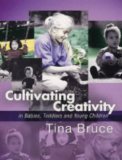Recommended Resources
Cultivating creativity in babies, toddlers and young children by Tina Bruce
Posted on January 17, 2009.
As practitioners we are always being reminded about taking photographic and video evidence of children during the day day because a picture can demonstrate a point really clearly. But how often do we find a book which takes this valuable advice? The first thing that you will notice about Tina Bruce’s book is the beautiful, full colour photographs throughout. These are often grouped so that the reader can see the process that is being described in the text.
The next thing is the way that the book can be read – either scanned through, picking out the information boxes or dipped into a chapter at a time or simply read end to end. With this in mind there is some repetition from chapter to chapter, which reinforces the central themes. These are:
- Anyone can be creative
- Good creativity needs incubation
- There are 3 kinds of creativity: everyday, specialist and world shattering
It is often noted throughout the book that creativity is hard work, the environment need to support creativity, as do the practitioners, and that creativity is not producing a creation, but is a process. For me this was the most resonant idea in the book. Too often as practitioners we talk about ‘doing a creative activity’ meaning that we will expect the children to make something, often within our own, narrow adult boundaries. Were the children in your setting allowed to make their own Christmas card using any material of choice and own design? How long was the idea allowed to incubate? Did everyone have to do a card?
Tina Bruce concentrates on the aspects of creativity:
- emergent beginnings
- the process of developing a creative thought or idea
- the product which (may or may not) emerges and this could be a scientific theory, dance or poem!
Sometimes the children don’t even know what they are creating and our adult interpretation should not be forced upon them. In fact, Bruce notes that a clear idea may restrict the creative process.
The case studies bring the subject to life with examples I could easily relate to. Gradually the theory is built to a final chapter about the three kinds of creativity with powerful examples of how this is achieved in adulthood in the arts, humanities and science. The book concludes with a useful page of bullet points on how to cultivate creativity generally.
I was a little disappointed that there were no pictures of children in chapter 6 – Emergent Beginnings – which covers babies and SEN. Whilst there are excellent examples for toddlers, pre-school and older early years, there is much less about babies in general.
Nonetheless, it is a good read, and it is very useful to be able to access the book at the different levels. It is also a useful source of practical information on the process of creativity and how to encourage this within various settings. I would strongly recommend it to any practitioner who is interested in creativity.

